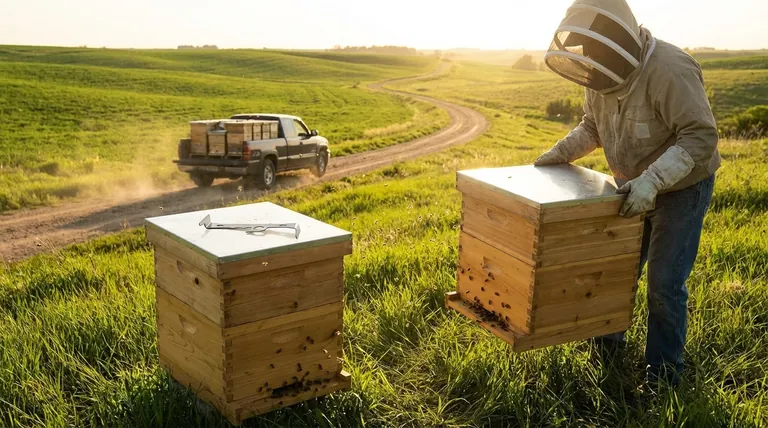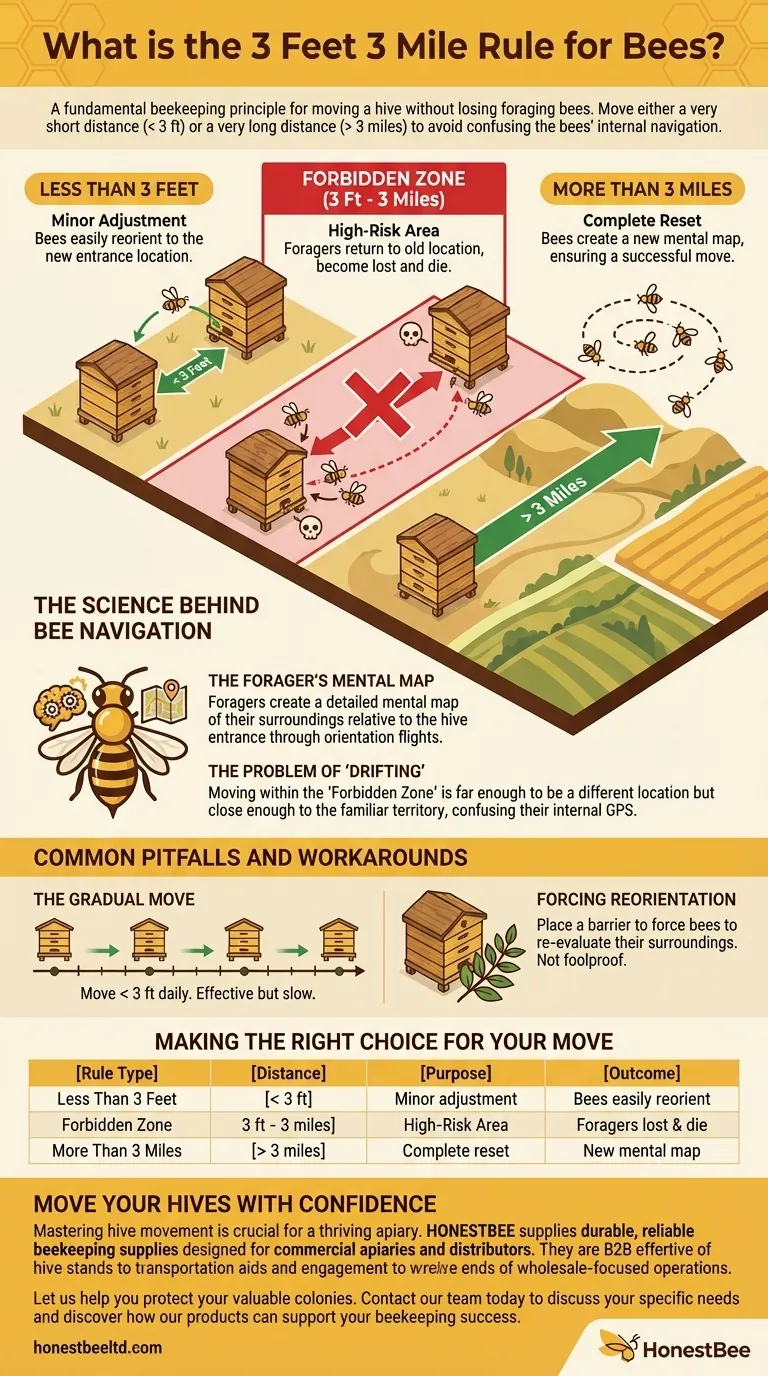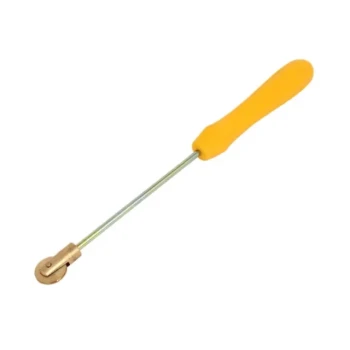The 3 feet, 3 mile rule is a fundamental beekeeping principle for moving a hive without losing your foraging bees. It dictates that you should only move a hive either a very short distance (less than 3 feet) or a very long distance (more than 3 miles) at any one time. Moving a hive any distance in between these two extremes risks confusing the bees' internal navigation, causing them to return to the hive's original location where they will become lost.
Moving a beehive appears simple, but a bee's powerful "GPS" can cause foragers to return to the hive's old location and perish. The '3 feet, 3 mile' rule is a critical guideline to prevent this loss by working with their navigational instincts, not against them.

The Science Behind Bee Navigation
The Forager's Mental Map
Foraging honeybees have a remarkable ability to navigate. When they first emerge from the hive, they perform orientation flights, creating a detailed mental map of their surroundings relative to the precise location of the hive entrance.
This internal map allows them to efficiently fly miles away to find nectar and pollen and return to the exact same spot without fail.
The Problem of "Drifting"
The "Forbidden Zone" for moving a hive is any distance between 3 feet and 3 miles. A move within this zone is far enough to be a different location, but close enough to still be within the bee's familiar, mapped territory.
When foragers leave the newly-moved hive, they fly out to forage and then attempt to return to the original spot memorized in their mental map. When the hive isn't there, they become disoriented, confused, and will often die trying to find it, depleting the colony of its experienced workforce.
Deconstructing the "3 Feet, 3 Mile" Rule
The "Less Than 3 Feet" Rule
A move of less than three feet is small enough that the bee can easily correct its course upon returning. The hive is still within their immediate field of perception.
They will notice the slight change as they leave and can easily reorient to the new entrance location. This is a minor adjustment that does not require them to rebuild their entire mental map.
The "More Than 3 Miles" Rule
A move of three miles or more places the hive in a completely new landscape. When the bees emerge for their first orientation flights, nothing is familiar.
This environmental shock forces them to discard their old mental map entirely. They have no choice but to create a brand new map centered on the hive's new location, effectively resetting their internal GPS.
Common Pitfalls and Workarounds
The Gradual Move
The most common way to move a hive across a yard (e.g., 50 feet) is to do it gradually. You move the hive no more than 3 feet each day until it reaches its final destination.
This is effective but very slow and labor-intensive. It allows the bees to adjust to the small change each day without triggering mass confusion.
Forcing Reorientation
For a single, slightly larger move within the same yard, some beekeepers try to force reorientation. This involves placing a physical barrier, like a leafy branch or a board, directly in front of the hive entrance.
When bees exit, they are forced to navigate around the obstacle. This interruption can make them stop and re-evaluate their surroundings, increasing the chance they will notice the hive has moved and re-map its location. This method is not foolproof and may still result in some forager loss.
Making the Right Choice for Your Move
To move a colony successfully, you must choose a strategy that aligns with their biology.
- If your primary focus is moving the hive across your yard: Commit to moving it less than 3 feet per day or attempt the reorientation barrier method for a single, slightly larger move.
- If your primary focus is moving the hive to a new property: Ensure the new location is well over 3 miles away to guarantee a complete and successful navigational reset.
- If you must move a hive a "medium distance" (e.g., one mile): This is the highest-risk scenario; first move the hive to a temporary location more than 3 miles away for 2-3 weeks, then move it to its final destination.
By understanding and respecting a bee's navigational instincts, you can move your hives safely and ensure your colony continues to thrive.
Summary Table:
| Rule Type | Distance | Purpose | Outcome |
|---|---|---|---|
| Less Than 3 Feet | < 3 ft | Minor adjustment | Bees easily reorient to the new entrance location. |
| Forbidden Zone | 3 ft - 3 miles | High-Risk Area | Foragers return to old location, become lost and die. |
| More Than 3 Miles | > 3 miles | Complete reset | Bees create a new mental map, ensuring a successful move. |
Move Your Hives with Confidence
Mastering hive movement is crucial for a thriving apiary. Whether you're a commercial beekeeper managing hundreds of hives or a distributor supplying equipment, having the right tools and knowledge is key.
HONESTBEE supplies durable, reliable beekeeping supplies and equipment designed for the demands of commercial apiaries and distributors. From hive stands to transportation aids, our wholesale-focused operations ensure you get the quality gear you need to manage your bees effectively.
Let us help you protect your valuable colonies. Contact our team today to discuss your specific needs and discover how our products can support your beekeeping success.
Visual Guide

Related Products
- HONESTBEE Advanced Ergonomic Stainless Steel Hive Tool for Beekeeping
- Professional Dual-End Stainless Steel Hive Tool for Beekeeping
- Professional Galvanized Hive Strap with Secure Locking Buckle for Beekeeping
- Professional 3-Bar Frame Grip with Integrated Hive Tool
- Yellow Plastic Bucket Pail Perch for Beekeeping
People Also Ask
- What is a hive tool and what are its uses? Master Your Hive Inspections with the Essential Beekeeper's Tool
- Why do hive tools have a hole? Unlock the Secret to Efficient Beekeeping
- What are the basic tools for beekeeping? Essential Starter Kit for Safe & Successful Hive Management
- What are the features of a regular hive tool? The Essential Multi-Tool for Every Beekeeper
- What are some common uses of a hive tool? Essential Multi-Purpose Tool for Every Beekeeper



















